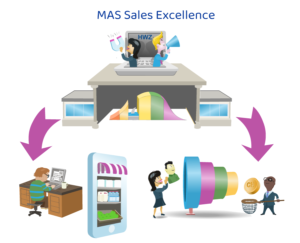Sales Excellence
Sales excellence is becoming more and more important in practice. Distribution systems face numerous challenges. Customers have already made up their minds 70% before they meet a sales person. E-commerce is steadily gaining in importance and multi-channel sales approaches are increasingly becoming the “new normal”. In doing so, the costs and the complexity as well as potentials at the customers have to be kept in a balance. Many companies simply try to cut costs during this time. Personnel costs in particular are often cut on the basis of simple considerations. The necessary systematic transformation of the company usually falls by the wayside. As a result, many new digital tools are being introduced, sales force resources are being cut, and pressure on the distribution system is being increased.
Sales Excellence is a management framework designed to help identify potential in sales and distribution and develop approaches to exploit it. The aim is to develop and expand competencies for systematic and continuous transformation.
SalesX includes the four dimensions:
- Information Management
- transformation
- Distribution strategy
- Sales Management
Sales Excellence Maturity Check
Assess your company’s sales excellence and get an overview of strengths and weaknesses. In addition, you will receive a benchmark to other companies and initial recommendations in the form of a PDF.
The sales training in Switzerland
The MAS Sales Excellence is the only master’s degree in Switzerland that focuses on sales and distribution. You will gain valuable skills to improve your sales skills, successfully manage your sales system and professionalize your customer relationship management. This takes into account current developments in the context of digitalization.
Our advice on the subject
There have never been more distribution channels than today and the complexity that comes with them. As a specialized consultancy, we support you in successfully shaping the coming transformation. Based on our Sales Excellence approach, we can systematically determine your strengths and weaknesses in sales and jointly leverage the existing potential.
The article introduces the model, distinguishes it from existing approaches and presents the key success factors.
Derivation of the Sales Excellence Model
There are three different models for the sales excellence approach in the sales literature: Belz et al., Homburg et al. and Pufahl. Belz et al. identify ten levers for improving sales excellence. Pufahl and Homburg et al. each assume four different dimensions. Pufahl names strategy, organization, controlling and personnel. Homburg et al. list sales strategy, sales management, information management and customer relationship management as dimensions of sales excellence. The sales excellence model of Belz et al. is difficult to relate to other models due to the lack of a basic systematic approach. The general statements on sales management in the model of Pufahl et al. provide only limited support for a specific improvement of sales excellence in an organization. The model of Homburg et al. features a structure and several specific recommendations for improving sales excellence. What all three models have in common is that digitization, whether in the form of digitalization, personal selling or e-commerce, is not mentioned or only mentioned in passing.
Only in the model of Homburg et al. information management is established as an important dimension of sales excellence. However, their study results lead them to conclude that improving information management in sales only generates an optimal return on investment up to a certain point. At first glance, this statement may seem to be correct, as only a few companies have comprehensive competencies in the area of information management. Our studies have shown that information management has the greatest potential for companies, especially in sales. The individual dimensions of our approach are presented in more detail below.
Information management dimension: Here, the quality of the customer value model is the most important success factor. Companies are challenged to improve the revenue and contribution margin customer value models or the non-existing customer value models in the direction of customer scoring or customer engagement values. Only an understanding of the value contribution for the customer and for the company allows optimal decisions to be made, for example with regard to sales force management or discount management in e-commerce.
Dimension Transformation: This level has the continuous review and adaptation of sales processes as the most important success factor. It is surprising that existing sales excellence models comprehensively address the structure of the sales system, but process design is still hardly considered. When optimizing processes, the most important thing is to proceed from the customer rather than from the organization. The focus should not be on the sales funnel, but on the individual customer journeys.
Dimension Sales Strategy: Here, the annual writing down of the sales strategy is the most important success factor. Only if the sales strategy is formulated and written down, it is understandable for all employees in sales and they can align their actions to it.
Dimension sales management: Here, following Homburg et al. interface management can be identified as the most important success factor. This includes four dimensions:
1. greater involvement of sales in the development of offerings,
2. the improvement of cross-selling,
3. The merging of marketing and sales in
holistic customer relationship management and
4. The decentralized design of sales excellence.
Successful sales systems strive for greater customer involvement in the development of offerings. The keyword co-creation sales illustrates the increasing integration of the customer in the development of the offer via the sales people of a company. Cross-selling is another important success factor in sales. Sales must be empowered to represent the company’s entire portfolio of services to customers, if possible. Due to the increasing size and complexity of the service portfolio, this requires digital support for the individual salesperson. Here it becomes clear how important it is to take greater account of digitization in sales excellence models.
In addition, digitization will lead to an increasing dissolution of the organizational separation of marketing and sales in many companies. If the customer uses the various touchpoints more and more individually and the purchase decision, whether B2B or B2C, has already been made by an average of 65 percent before the customer reaches the point-of-sale or the salesperson, the customer will be able to make an informed decision.
When it comes to marketing and sales, it is important to adopt a more integrative perspective. The increasing importance of e-commerce will also support this development. Finally, it should be noted that companies are establishing central sales excellence units with the aim of analyzing and transforming the sales system. In this context, Belz et al. comprehensively to the problem of a stand-alone sales excellence position at headquarters. Sales excellence should therefore be understood as a decentralized task and, if possible, anchored in the sales system.



